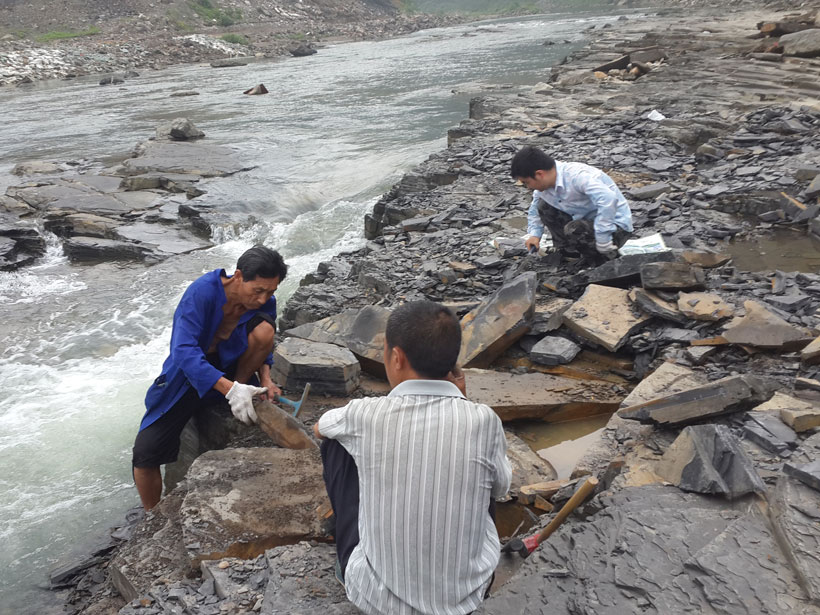Thousands of rare soft-tissue fossils from the Cambrian period have been unearthed along a riverbank in China. More than half of the taxa of these fossils, collectively called the Qingjiang biota, are new to science.
“The Qingjiang biota is 10 million years older than the Burgess Shale, closer to initial diversification of metazoans,” or multicellular animals, said Xingliang Zhang, a geologist at Northwest University in Xi’an, China, and lead researcher on the project. The new fossil deposit shows “lots of potential,” he said. “We [have] just started to work on so many new taxa.”
The team published this discovery today in Science.
A Unique Window into Early Animal Life
Soft-tissue fossils are very rare because skin, eyes, guts, and brains are much more difficult to preserve than skeletons. There are only a few deposits worldwide where the mineralogy of the rocks supports the preservation of these soft tissues.
These types of fossils from the Cambrian period (541–485 million years ago) give clues about the earliest years of animal life and the largest diversification of life on Earth, called the Cambrian explosion.
Zhang and his team discovered the Qingjiang biota along the banks of the Danshui River in the Hubei Province of the China. During four field campaigns, researchers collected 4,351 specimens that represent 101 multicellular taxa and 8 algal forms.
The Qingjiang biota is roughly 518 million years old. It is about the same age as the nearby Chengjiang biota and slightly older than those at Canada’s Burgess Shale, the location for which these types of fossils are named.
“The Qingjiang biota is remarkable in how it so dramatically opens up another, and yet unique, window to the beginnings of diverse animal life on Earth’s surface.”
The team found that Qingjiang rivals, and might even exceed, the Burgess Shale deposits in terms of its taxonomic diversity. Only a few of the species found in Qingjiang were previously discovered in other locations, and 53% of the animals represent previously unknown taxa.
“The Qingjiang biota is remarkable in how it so dramatically opens up another, and yet unique, window to the beginnings of diverse animal life on Earth’s surface,” said Emma Hammarlund, a geobiologist at Lund University in Sweden who was not involved with this research. “What we can see through this window is nothing short of astounding.”
Jellies, Combs, Sponges, and Tentacles
Researchers found that the Qingjiang fossils are in a more pristine condition than those from Burgess Shale and Chengjiang.
“This is where the Qingjiang biota is truly remarkable, and certainly worthy of attention, by how it presents its members with amazing detail of shapes, antennas or eyes,” Hammarlund said. “The rocks are much less weathered than at Chengjiang and less cooked than at Burgess Shale.”
“As if that wasn’t enough,” she continued, “the biota has also preserved its flimsy ones, so both jellyfish, sometimes even with tentacles, and comb jellies appear preserved. This contribution from the Qingjiang will certainly add to our understanding of the evolution, and resilience, of also the most primitive animals.”
.

What’s more, the biota includes fossils of the same taxa spanning larval, juvenile, and adult developmental stages. This discovery could give an unprecedented look into the development of individual species, the team wrote.
More than a third of the Qingjiang biota are cnidarian fossils—stinging creatures like jellyfish, box jellies, and anemones that are thought to have been abundant during the early Cambrian but are underrepresented in the fossil record.
The array of cnidarians “provide[s] the tantalizing prospect of illuminating some of the lowest branches of the animal tree,” according to Ross Anderson, a paleobiologist at All Souls College at the University of Oxford in the United Kingdom, who was not involved with this study.
Neighboring Fossils, Different Paleoenvironments
The Qingjiang and Chengjiang biotas are the same age and from the same paleogeographic region but have only an 8% overlap in their taxa. That distinction could suggest that the two deposits developed in response to different paleoenvironmental conditions, the team wrote.
“The Qingjiang biota might just be the best yet discovered.”
“The differences in the biological composition of Qingjiang versus the neighboring Chengjiang biota really highlight the ecological diversity of early animal ecosystems,” Anderson said. “Burgess Shale–type deposits are of vital importance to our understanding of early animal evolution. The Qingjiang biota might just be the best yet discovered.”
With two very different fossil deposits discovered so close together, Zhang and his team continue to hunt for more.
“I have been working on Burgess Shale–type fossils for many years and keep searching for good fossil localities and collecting fossils every year,” Zhang said. “If we can find Burgess Shale–type preservation in the first 20 million years of the Cambrian anywhere in the world,” Zhang said, “it would be great!”
—Kimberly M. S. Cartier (@AstroKimCartier), Staff Writer
Citation:
Cartier, K. M. S. (2019), Scientists discover pristine collection of soft-tissue fossils, Eos, 100, https://doi.org/10.1029/2019EO118831. Published on 21 March 2019.
Text © 2019. AGU. CC BY-NC-ND 3.0
Except where otherwise noted, images are subject to copyright. Any reuse without express permission from the copyright owner is prohibited.
Text © 2019. AGU. CC BY-NC-ND 3.0
Except where otherwise noted, images are subject to copyright. Any reuse without express permission from the copyright owner is prohibited.

